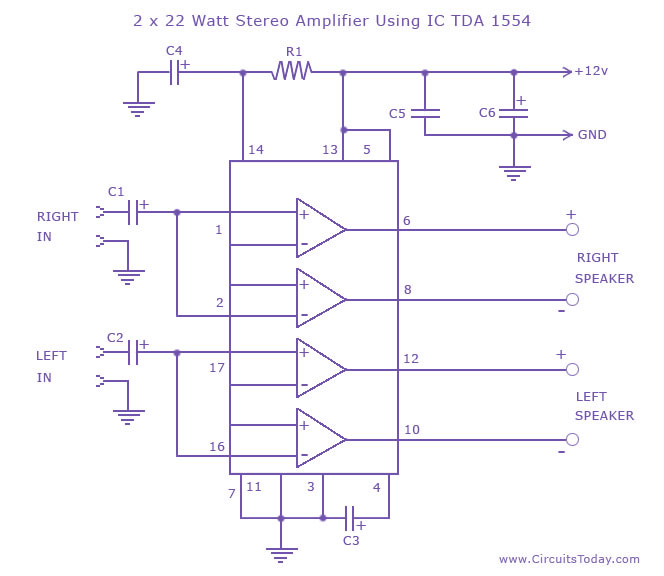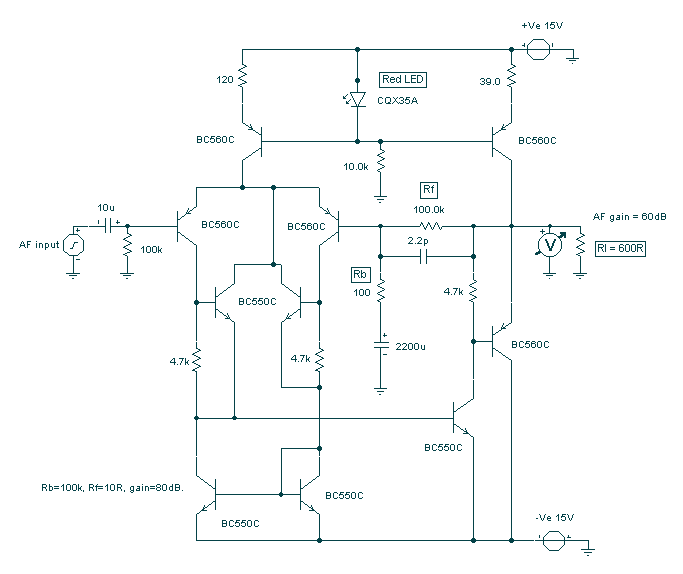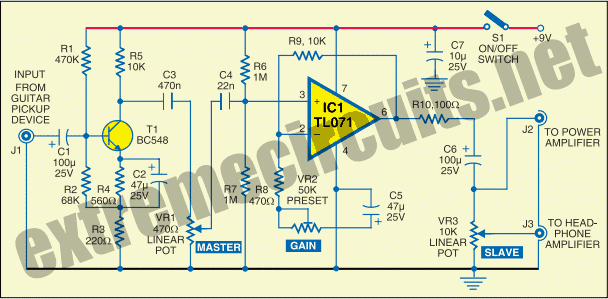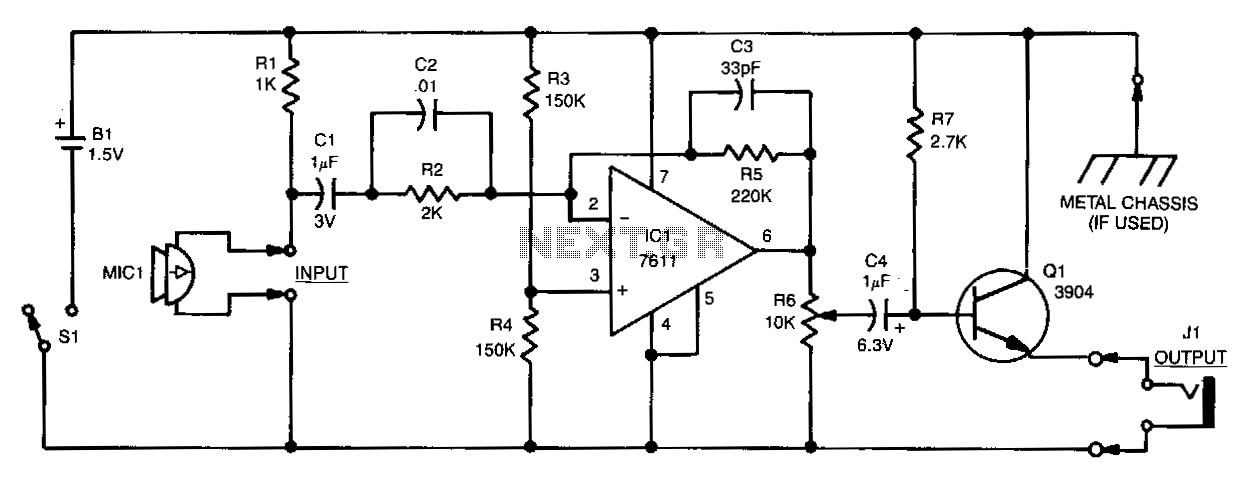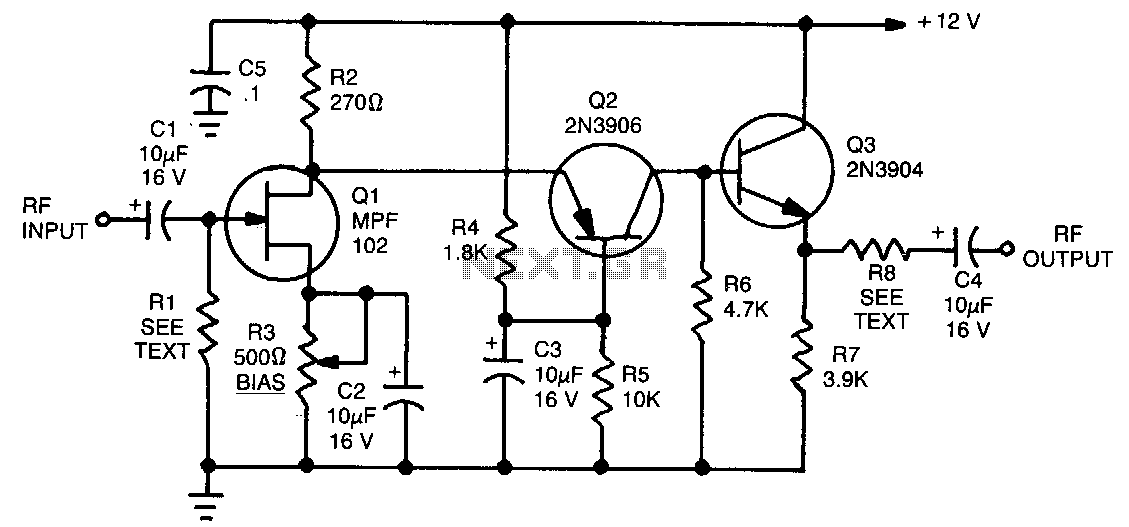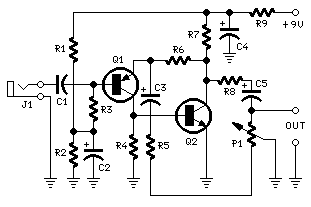
Buffer Amplifier

A hi-fi preamplifier designed to convert high output impedance amplifiers to 600-ohm outputs.
The described hi-fi preamplifier is engineered to facilitate the interfacing of high output impedance audio sources with low impedance loads, specifically targeting a standard output impedance of 600 ohms. This is particularly relevant in professional audio environments where matching impedances is crucial for optimal signal transfer and minimal signal loss.
The preamplifier typically includes a high-gain stage, which may employ operational amplifiers (op-amps) or discrete transistor configurations to achieve the desired amplification without introducing significant noise or distortion. The input stage is designed to handle high impedance signals, ensuring that the source device's performance is not adversely affected.
Key components of the circuit may include:
1. **Input Stage**: This section may utilize a high-impedance buffer to isolate the input from the subsequent amplification stages. It prevents loading effects that could degrade the signal quality from the source instrument or device.
2. **Gain Stage**: This critical section amplifies the signal to a level suitable for driving the 600-ohm output. The gain can be set using feedback resistors in an op-amp configuration or by selecting appropriate transistor biasing in a discrete design.
3. **Output Stage**: The output stage is designed to present a 600-ohm load to the next stage in the audio chain. This may involve a transformer or a resistor network that ensures the output impedance is accurately matched.
4. **Power Supply**: The preamplifier requires a stable power supply, typically dual-rail (positive and negative) to accommodate the AC audio signals. This ensures that the entire signal range is amplified without clipping.
5. **Protection Circuitry**: To safeguard against overload and ensure longevity, the design may incorporate fuses, diodes, or other protective elements.
6. **Filtering**: Capacitors may be employed at various points in the circuit to filter out unwanted high-frequency noise, ensuring that only the desired audio frequencies pass through.
Overall, this hi-fi preamplifier serves as a crucial interface in audio systems, enabling high output impedance devices to effectively drive 600-ohm loads while maintaining audio fidelity. Proper design and component selection are essential to achieve a low noise floor and high linearity, ensuring the integrity of the audio signal throughout the amplification process.A hifi preamplifier designed to convert high output impedance amplifiers to 600 ohm outputs.. 🔗 External reference
The described hi-fi preamplifier is engineered to facilitate the interfacing of high output impedance audio sources with low impedance loads, specifically targeting a standard output impedance of 600 ohms. This is particularly relevant in professional audio environments where matching impedances is crucial for optimal signal transfer and minimal signal loss.
The preamplifier typically includes a high-gain stage, which may employ operational amplifiers (op-amps) or discrete transistor configurations to achieve the desired amplification without introducing significant noise or distortion. The input stage is designed to handle high impedance signals, ensuring that the source device's performance is not adversely affected.
Key components of the circuit may include:
1. **Input Stage**: This section may utilize a high-impedance buffer to isolate the input from the subsequent amplification stages. It prevents loading effects that could degrade the signal quality from the source instrument or device.
2. **Gain Stage**: This critical section amplifies the signal to a level suitable for driving the 600-ohm output. The gain can be set using feedback resistors in an op-amp configuration or by selecting appropriate transistor biasing in a discrete design.
3. **Output Stage**: The output stage is designed to present a 600-ohm load to the next stage in the audio chain. This may involve a transformer or a resistor network that ensures the output impedance is accurately matched.
4. **Power Supply**: The preamplifier requires a stable power supply, typically dual-rail (positive and negative) to accommodate the AC audio signals. This ensures that the entire signal range is amplified without clipping.
5. **Protection Circuitry**: To safeguard against overload and ensure longevity, the design may incorporate fuses, diodes, or other protective elements.
6. **Filtering**: Capacitors may be employed at various points in the circuit to filter out unwanted high-frequency noise, ensuring that only the desired audio frequencies pass through.
Overall, this hi-fi preamplifier serves as a crucial interface in audio systems, enabling high output impedance devices to effectively drive 600-ohm loads while maintaining audio fidelity. Proper design and component selection are essential to achieve a low noise floor and high linearity, ensuring the integrity of the audio signal throughout the amplification process.A hifi preamplifier designed to convert high output impedance amplifiers to 600 ohm outputs.. 🔗 External reference
